Last Updated on: September 1, 2025Choosing the right stadium lighting is critical for a flawless broadcast. A poor choice can ruin the viewing experience and reflect badly on the entire event.
For a broadcast environment, effective LED floodlights must deliver high, flicker-free brightness (high TLCI), excellent color accuracy (CRI>80), and precisely controlled beam angles. This combination ensures that the action looks sharp, vibrant, and true-to-life on camera, especially during slow-motion replays.
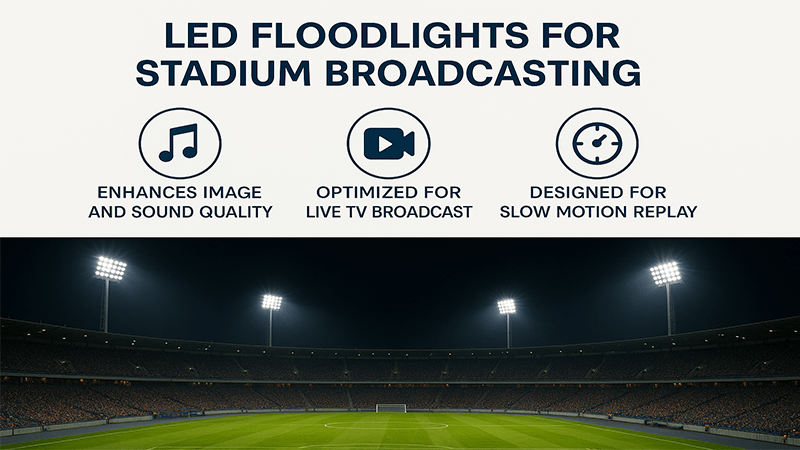
Choosing the right lighting for a stadium is about more than just making the field bright. For broadcasting, every detail matters. The difference between a world-class broadcast and an amateurish one often comes down to the quality of the light itself. During my years in this industry, I’ve seen how easy it is to be misled by specifications on a sheet that don’t hold up in the real world. We need to look deeper than the marketing claims to understand what truly makes a floodlight effective for the demanding environment of television. Let’s break down the essential factors you need to consider.
What are the benefits of LED floodlights?
Old metal halide lights drain your budget with high energy use and constant maintenance. This eats into profits and creates logistical headaches. The solution is clear: LEDs offer huge savings.
The main benefits of LED floodlights are dramatic energy savings (up to 75%), a much longer lifespan of over 50,000 hours, and far lower maintenance costs. They also offer instant-on brightness, superior light control, and enhanced color rendering for a better overall experience.
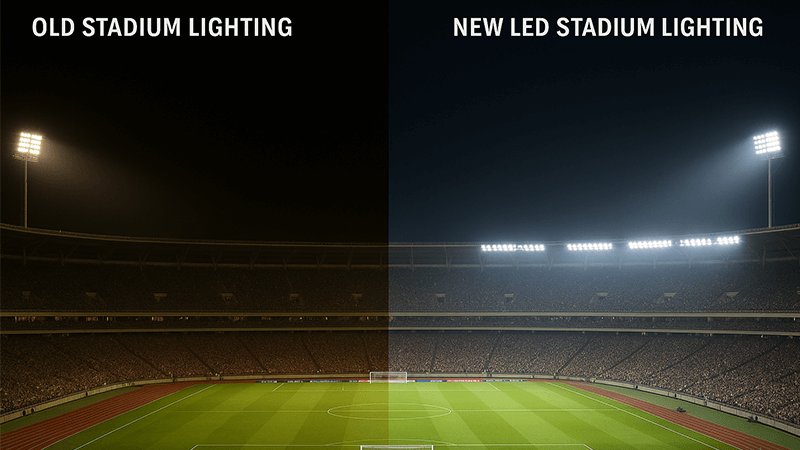
When I first started helping clients switch from traditional lighting to LED, the benefits were immediately obvious. The biggest win is always the operational cost savings. But the advantages go much further than that. A key area to watch out for, especially for a purchasing manager like Shaz, is the warranty. I’ve seen smaller factories offer an incredible 10-year warranty. It sounds great, but I’ve learned to be skeptical. Often, they make this promise knowing they might not be in business that long, or you won’t be able to find them. Even if you can, the warranty terms are designed to make you give up. They might demand the original proof of purchase from years ago, or require you to pay for expensive international shipping and labor costs, making a claim impractical. A reliable supplier’s warranty is backed by their reputation and fair terms, not just a big number on a datasheet.
Here is a simple breakdown of LED benefits compared to the old Metal Halide (MH) technology:
| Feature |
LED Floodlight |
Metal Halide (MH) Floodlight |
| Energy Usage |
Low (saves 60-75% energy) |
High |
| Lifespan |
50,000 – 100,000 hours |
6,000 – 15,000 hours |
| Maintenance |
Very low, no bulb replacement |
Frequent, requires bulb and ballast replacement |
| Turn-On Time |
Instant |
15-30 minute warm-up period |
| Control |
Full dimming and zoning control |
Limited to on/off |
| Light Quality |
High, consistent color and brightness |
Color can shift over time, noticeable flicker |
These benefits create a better environment for everyone, from the facility manager saving money to the players and fans enjoying better, safer visibility.
How are stadium lights so bright?
Getting intense and even lighting across a massive field is a huge engineering challenge. Any dark spots or glare can interfere with the game and ruin the view. The secret is combining raw power with precision.
Stadium lights produce immense brightness by using arrays of high-output LED chips. This powerful light is then precisely controlled and directed by advanced optical lenses and reflectors, ensuring maximum intensity on the field without wasting light or creating glare for spectators.
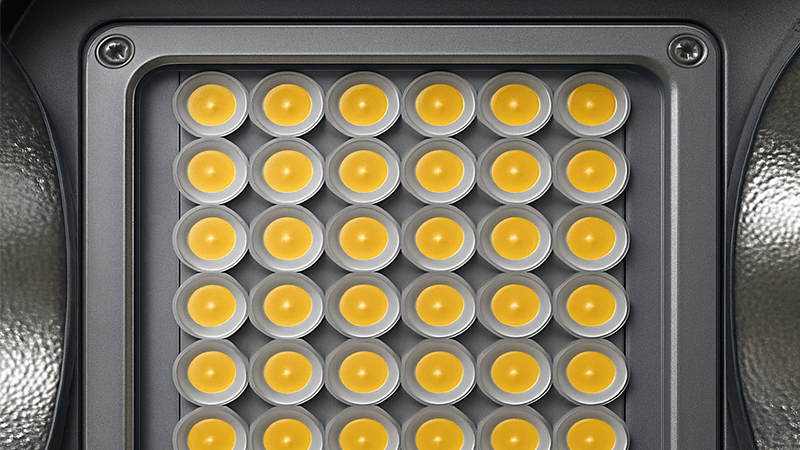
The incredible brightness you see in a modern stadium comes from a combination of two key elements: the LED chips themselves and the optics that shape their light. It’s not just about being bright; it’s about being smart with that brightness.
The Power of LED Chips
The engine of the floodlight is the LED chip. Top-tier manufacturers use chips from reputable brands that deliver very high efficacy, measured in lumens per watt. This means you get more light for every watt of electricity consumed, which is crucial for energy efficiency. The sheer number of these chips clustered together in a large fixture is what generates the raw, powerful light needed to illuminate a field from a high mast.
The Magic of Optics
Raw power is useless if it’s not controlled. This is where optics come in. Each LED chip or small group of chips is paired with a lens. These lenses are designed with specific beam angles—some narrow to throw light hundreds of feet to the center of the field, and others wider to illuminate areas closer to the stands. This precise control is what creates a uniformly lit surface. However, this high-tech design comes with a practical consideration I always warn my clients about. To protect these sensitive electronics from the elements and achieve high IP ratings, many floodlights are completely sealed, often injected with potting glue. While this makes them very waterproof, it also makes them non-serviceable. I once had a client who was initially thrilled with a sealed design, only to find out that when a single driver failed two years later, the entire expensive fixture had to be replaced. There was no way to repair it. For a purchasing manager, asking about modular design and repairability is just as important as asking about lumens and wattage.
What kind of bright light would typically be used to illuminate a sports stadium?
Not just any bright light will work for a professional stadium. The wrong type of light can cause major problems for television cameras, affecting the quality of the broadcast. The industry standard is a very specific type of LED.
Modern stadiums exclusively use high-mast LED floodlights. These are not standard floodlights; they are specifically engineered for sports applications with high Color Rendering Index (CRI), and a high Television Lighting Consistency Index (TLCI) to ensure flicker-free, broadcast-quality illumination.
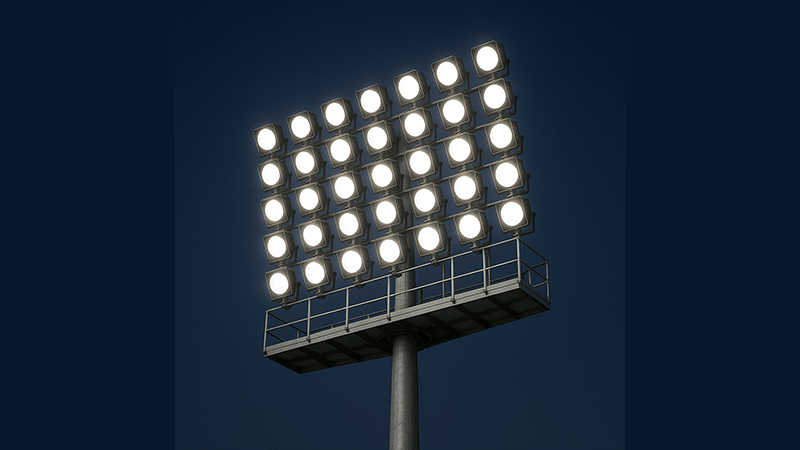
When you are sourcing lights for a stadium, the specifications list is long, but some are more critical than others, especially for broadcasting. Shaz, with your experience, you know that suppliers sometimes use marketing terms that can be misleading. One of the most common I’ve encountered is the "flicker-free" claim.
Beyond the Naked Eye: Flicker and TLCI
A supplier might say their light is flicker-free, and to your eyes, it will look perfectly stable. The problem is that a television camera, especially in slow motion, sees the world differently. I always tell my clients to do a simple test: pull out your smartphone, put the camera in slow-motion mode, and point it at the light source. A low-quality light will show obvious banding and strobing on your screen. This is the flicker that will ruin a broadcast. The true professional metric isn’t a simple claim; it’s the Television Lighting Consistency Index (TLCI). This is a score out of 100 that measures how well a light source will perform on camera. For any professional broadcast, you must insist on a TLCI score of 90 or higher.
Seeing True Colors: CRI and CCT
Here are the key lighting parameters to specify for a broadcast-ready stadium:
| Parameter |
Required Specification |
Why It’s Important |
| Color Rendering Index (CRI) |
>80 (90+ is ideal) |
Ensures colors of jerseys, grass, and advertisements look natural and vibrant on camera. |
| Correlated Color Temp (CCT) |
5000K – 6000K (Daylight) |
Provides a crisp, clean white light that mimics natural daylight for optimal clarity. |
| TLCI |
>90 |
Guarantees flicker-free performance for all cameras, including super slow-motion replays. |
| Uniformity |
>0.7 |
Ensures an evenly lit field with no distracting hot spots or dark patches. |
Insisting on verified data for these parameters, especially TLCI, is the only way to guarantee the lights will meet the demands of a modern sports broadcast.
Do stadiums use LED lights?
Some people wonder if this advanced lighting technology has truly been adopted by major venues. When you see a perfectly lit field on TV, what are you looking at? The answer is a definitive yes.
Yes, almost all new stadium constructions and major retrofits now exclusively use LED lighting. The switch from outdated technologies like metal halide is nearly complete due to LED’s overwhelming advantages in performance, efficiency, control, and broadcast-readiness.
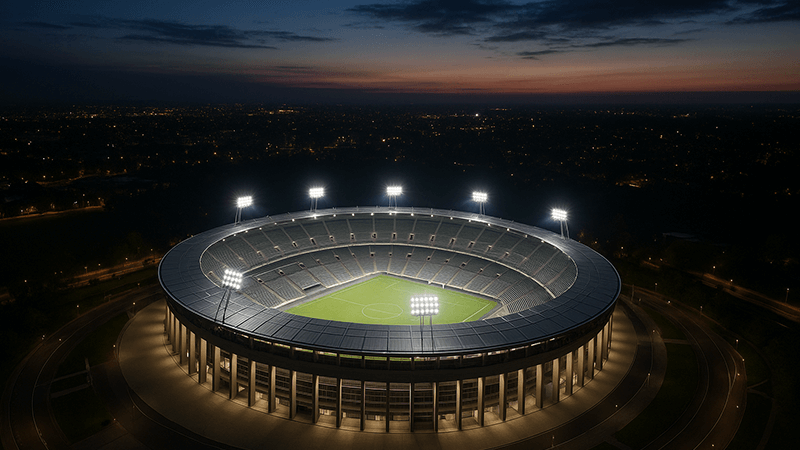
The transition to LED in stadiums is a global trend. The reasons we’ve discussed—energy savings, long life, and superior light quality—make the business case undeniable. However, the success of a stadium lighting project doesn’t just depend on buying a good product. The installation is just as critical, and this is where I’ve seen costly mistakes happen.
The Realities of Retrofitting
Switching a stadium from metal halide to LED is a major undertaking. It isn’t just a bulb swap. It involves replacing heavy, old fixtures with new ones, often requiring new mounting brackets and wiring. This is a complex job happening hundreds of feet in the air, and cutting corners during installation can compromise the entire system.
A Weak Link in the Chain: IP Ratings and Installation
This brings me to a crucial insight about Ingress Protection, or IP ratings. A manufacturer will proudly advertise their floodlight as IP66, meaning it’s highly resistant to dust and water. But what they don’t always highlight is that this rating often applies only to the main body of the lamp. The weak point is almost always the wiring connection. I worked on a project where the client invested heavily in top-quality IP66 floodlights. However, the installation contractor rushed the job and didn’t properly seal the junction boxes where the fixture’s cable connects to the main power line. They didn’t use waterproof sealing mastic or wrap the connection correctly with insulation tape. Within a year, several fixtures started failing. Water vapor had slowly worked its way in through these poorly sealed connection points, bypassing the fixture’s excellent IP rating and corroding the electronics from the inside out. For a purchasing manager, it’s vital to not only specify a high-quality product but also to ensure the installation protocols are strictly followed. A great light can be defeated by a small amount of water getting in through the wrong place.
Conclusion
Effective stadium lighting requires LED floodlights with high CRI and a broadcast-ready TLCI rating. It’s crucial to look beyond marketing claims and verify a supplier’s promises on warranties and real-world performance.